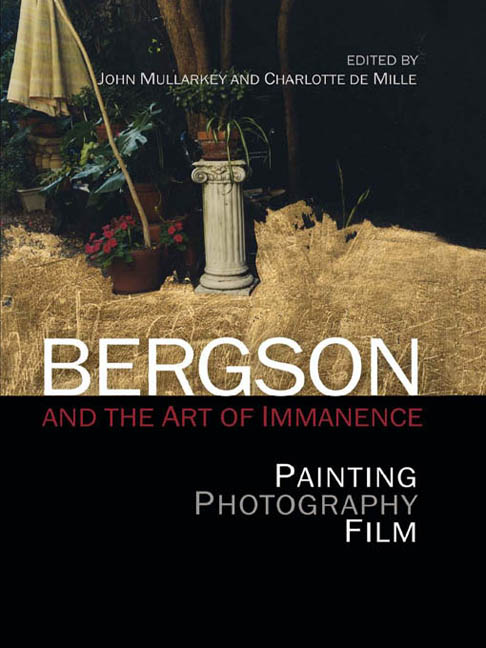Book contents
- Frontmatter
- Contents
- List of Illustrations
- Notes on Contributors
- Introduction: Art's Philosophy – Bergson and Immanence
- Part I Bergson, Art, History
- Part II Unconditional Practice
- 7 The Matter of the Image: Notes on Practice-Philosophy
- 8 Pasearse: Duration and the Act of Photographing
- 9 Duration and Rhetorical Movement
- 10 A Diagram of the Finite-Infinite Relation: Towards a Bergsonian Production of Subjectivity
- Part III Immanence of the Visible
- Afterword: An Art Historical Return to Bergson
- Index
9 - Duration and Rhetorical Movement
from Part II - Unconditional Practice
Published online by Cambridge University Press: 07 December 2017
- Frontmatter
- Contents
- List of Illustrations
- Notes on Contributors
- Introduction: Art's Philosophy – Bergson and Immanence
- Part I Bergson, Art, History
- Part II Unconditional Practice
- 7 The Matter of the Image: Notes on Practice-Philosophy
- 8 Pasearse: Duration and the Act of Photographing
- 9 Duration and Rhetorical Movement
- 10 A Diagram of the Finite-Infinite Relation: Towards a Bergsonian Production of Subjectivity
- Part III Immanence of the Visible
- Afterword: An Art Historical Return to Bergson
- Index
Summary
The two paintings we see in reproduction are James McNeill Whistler's Symphony in White, No. 1: The White Girl (1862) (Figure 9.1) and Edouard Manet's Luncheon on the Grass (1862) (Figure 9.2), but they are qualitatively multiple and the crowd writing this chapter sees many of them. The paintings share a history as successful scandals at the 1863 Paris refusals’ salon, after the academy had denied them wall space in the official salon. In their own time, these paintings were dissident works through their disruption of representative normalcy and their ambiguous, defiant gaze; however, their time is not their own. Both paintings contain past and future art objects and writings, which surge through their canvases. Art history has identified many of these works, and its writing can be seen to be transformative. More has been written about Luncheon on the Grass than about The White Girl, though art historical writing has elaborated art history's influence in both paintings. For example in Luncheon on the Grass there is Giorgione/Titian's Pastoral Concert (c. 1508), Marcantonio Raimondi after Raphael's Judgement of Paris (ca. 1515–16), Antoine Watteau's Tranquil Love (1718), Pablo Picasso's The Young Ladies of Avignon (Les Demoiselles d'vignon) (1907); and in The White Girl Jean-Baptiste Oudry's White Duck (1753), Watteau's Pierrot (Le Grand Gilles) (1717–19), Bartolome Esteban Murillo's Immaculate Conception of the Escorial (1678). The revisionary art historical project is perhaps more obvious in Luncheon on the Grass but is equally at work in The White Girl. Art historical identification is not supplementary but integral to the work because it realises possibility. The histories of these precedent and antecedent works can be thought of as transforming Luncheon on the Grass and The White Girl, which work retroactively upon them. To what extent, then, can art historical writing be seen as altered by and altering the history which these two paintings share in 1863? Michael Fried germanely refers to ‘the generation of 1863’ and this year is always being generated, by 1678, 1996, 1907, 1753 as recently as 2012.
- Type
- Chapter
- Information
- Bergson and the Art of ImmanencePainting, Photography, Film, Performance, pp. 148 - 164Publisher: Edinburgh University PressPrint publication year: 2013



